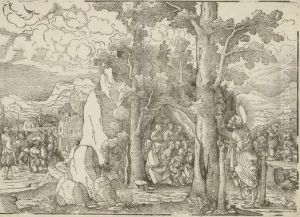Frans Crabbe Van Espleghem Paintings
Frans Crabbe van Espleghem, born in 1480 in Mechelen, present-day Belgium, was a notable figure in the Northern Renaissance, particularly within the Flemish school of painting. His life and work bridged the late Gothic and early Renaissance periods, reflecting the transitional nature of art during the 16th century in Northern Europe. Despite the scarcity of documented details about his personal life, Crabbe's artistic legacy is preserved through his engravings, paintings, and contributions to the development of printmaking techniques of his time.
Crabbe was primarily known for his work as an engraver and painter, with a style that demonstrated both intricate detail and a profound depth of emotional expression. His engravings often depicted religious themes, allegorical scenes, and classical mythology, showcasing his mastery over the burin and his innovative approach to composition and perspective. These works not only highlight his technical skill but also reflect the humanist interests of the Renaissance, merging classical knowledge with contemporary theological thought.
Throughout his career, Frans Crabbe van Espleghem was influenced by the Italian Renaissance, yet his work remained deeply rooted in the Flemish tradition. This is evident in his meticulous attention to detail, especially in his treatment of textures and light, characteristics that align him with other Flemish masters such as Hieronymus Bosch and Pieter Bruegel the Elder. Despite these influences, Crabbe developed a distinctive style that emphasized the narrative and symbolic aspects of his subjects.
His contributions to the arts extend beyond his own creations. Crabbe played a significant role in the early development of printmaking in Northern Europe, a process that was rapidly evolving during his lifetime. By experimenting with engraving techniques, he helped elevate the medium from a mere reproductive process to an esteemed art form, capable of conveying complex ideas and emotions.
Frans Crabbe van Espleghem passed away in 1553 in Mechelen. While he may not be as widely recognized as some of his contemporaries, his work has gained appreciation for its artistic merit and historical significance. Today, his engravings and paintings are studied for their contribution to the Northern Renaissance and their reflection of the cultural and intellectual currents of 16th-century Europe.
